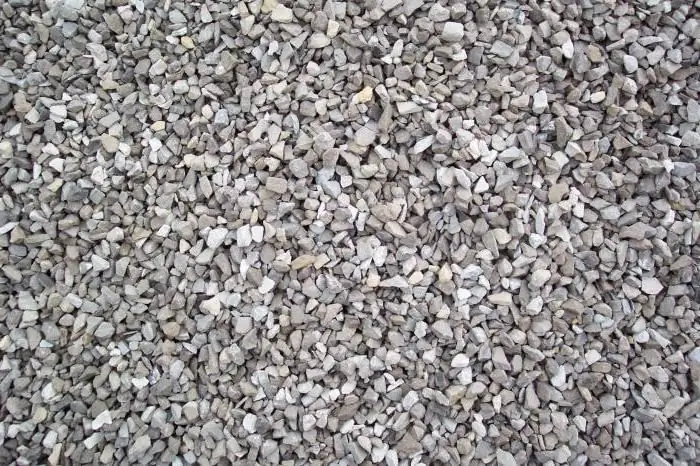2025 Author: Howard Calhoun | [email protected]. Last modified: 2025-01-24 13:10:34

Loose or lumpy basic building materials according to technical regulations vary in size. When sorting materials by sieving through a system of sieves, the fraction is determined. This means crushed stone or sand is separated according to particle or grain size.
What fractions are rubble?
The most common material in any construction is crushed stone. It is used for the device of road pillows, blind areas, it is a component in the concrete mixture. In each case, a certain size of crushed stone with its inherent physical characteristics is used. GOST provides that a fraction is the size of a physical unit of a stone that fits into the established framework. There are two main standard fractions (5-25 mm and 25-60 mm) that are used in construction. Modern equipment allows screening of crushed stone in narrower values, which are required for the implementation of individual tasks - from the smallest (up to 1 centimeter) to very large (from 12 to 30 centimeters).
What do you needrubble?

Industrial production of concrete and reinforced concrete structures, as well as asph alt, involves the use of a fine fraction of crushed stone - from 5 to 20 mm. When constructing tram tracks, railway embankments, road cushions, larger crushed stone (20/65 or 40/70 mm fractions) is more often used.
Large fractions are suitable for building foundations, and in landscape work they use the largest stone - up to 30 cm.
Thus, a fraction is the size of crushed stone that has been selected, prepared and tested in accordance with the requirements of GOST.
The common indicator for all stone fractions is considered to be the cubic shape of the particles, which is achieved in the process of crushing.
Sand fractions and scope
Sand is used not only in construction, but also in industry, for example, for the manufacture of insulation or glass, the production of adhesive and dry mixes, fillers, self-leveling floors, molds, and sandblasting. To avoid problems with the choice of raw materials, you need to know its characteristics and purchase exactly the sand that is needed for a particular type of work.

Sand is classified according to its origin and processing method. It can be river, sea, quarry, quartz, perlite, and each type has its own regulatory document. For example, the GOST standards governing the parameters of raw materials used in cement testing distinguish between polyfractional and monofractional quartz sand. referenceconsidered to be sand from the deposits of the Czech Cretaceous Region.
A common characteristic for sands of different origin is the particle size modulus (fraction) - this is when most of the particles are approximately the same size. So, sand, consisting of grains up to 0.5 cm in diameter, is referred to as very large. Large - 2.5-3.5 mm, medium - 1-2.5 mm, small - from 0.5 to 1.5 millimeters, and smaller grains of sand are classified as "fine sand".
River sand is an ideal raw material for the production of concrete products, and quarry sand is ideal for mixing masonry or plaster mortars, foundation works. Quartz sand is mainly used for the production of tiles and polymer products, earthenware and porcelain, for water filtration, welding materials and molds.
Recommended:
Loose material (sand, crushed stone): production and sale

Sand and crushed stone are used as bases for various buildings and landscaping, as well as aggregates for concrete
Types of crushed stone: description, characteristics, scope and origin

Crushed stone is a crushed stone and is divided into fractions according to its size. Technical characteristics such as flakiness, density, frost resistance, fraction, radioactivity affect the areas of use of crushed stone and its cost
Crushed stone: types, characteristics, applications and reviews

Crushed stone, the types of which will be described in more detail below, is a building material obtained as a result of the initial grinding and subsequent sifting of rocks
Crushed-stone-mastic asph alt concrete (ShMA): GOST, properties and characteristics

According to GOST, roads must be laid using asph alt concrete, which contains a stabilizing component. Its properties and appearance are of great importance for improving the quality of the final material, its transportation, preparation and installation. Additives are structuring fibrous. They allow you to maintain uniformity and help keep hot bitumen on the surface of crushed stone
Density of crushed stone - gravel, granite, limestone and slag. Bulk density of crushed stone: coefficient, GOST and definition

Crushed stone is a free-flowing, inorganic and granular material obtained by artificial crushing. It is divided into primary and secondary. This is an important fact. Primary - the result of processing natural stone: pebbles, boulders, pumice and other materials. Secondary is obtained by crushing construction waste, such as concrete, asph alt, brick. In this text, we will consider in more detail such a property as the density of crushed stone

